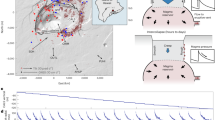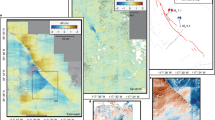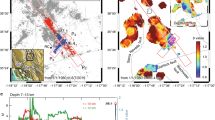Abstract
Aftershocks occurring on faults in the far-field of a large earthquake rupture can generally be accounted for by changes in static stress on these faults caused by the rupture1,2. This implies that faults interact, and that the timing of an earthquake can be affected by previous nearby ruptures3,4,5,6. Here we explore the potential of small earthquakes to act as ‘beacons’ for the mechanical state of the crust. We investigate the static-stress changes resulting from the 1992 Landers earthquake in southern California which occurred in an area of high seismic activity stemming from many faults. We first gauge the response of the regional seismicity to the Landers event with a new technique, and then apply the same method to the inverse problem of determining the slip distribution on the main rupture from the seismicity. Assuming justifiable parameters, we derive credible matches to slip profiles obtained directly from the Landers mainshock7,8. Our results provide a way to monitor mechanical conditions in the upper crust, and to investigate processes leading to fault failure.
This is a preview of subscription content, access via your institution
Access options
Subscribe to this journal
Receive 51 print issues and online access
$199.00 per year
only $3.90 per issue
Buy this article
- Purchase on Springer Link
- Instant access to full article PDF
Prices may be subject to local taxes which are calculated during checkout



Similar content being viewed by others
References
Stein, R. S. & Lisowski, M. The 1979 Homestead Valley earthquake sequence, California: Control of aftershock and postseismic deformation. J. Geophys. Res. 88, 6477–6490 (1983).
Reasenberg, P. A. & Simpson, R. W. Response of regional seismicity to the static stress change produced by the Loma Prieta earthquake. Science 255, 1687– 1690 (1992).
Hudnut, K. W., Seeber, L. & Pacheco, J. Cross-fault triggering in the November 1987 Superstition Hills earthquake sequence, southern California. Geophys. Res. Lett. 16, 199–202 ( 1989).
Jaumé, S. C. & Sykes, L. R. Changes in the state of stress on the southern San Andreas Fault resulting from the California earthquake sequence of April to June 1992. Science 258, 1325–1328 (1992).
Harris, R. A. & Simpson, R. W. Changes in static stress on southern California faults after the 1992 Landers earthquake. Nature 360, 251–254 (1992).
Stein, R. S. The role of stress transfer in earthquake occurrence. Nature 402, 605–609 (1999).
Wald, D. J. & Heaton, T. H. Spatial and temporal distribution of slip for the 1992 Landers, California, earthquake. Bull. Seismol. Soc. Am. 84, 668–691 ( 1994).
Hudnut, K. W. et al. Seismic displacement of the 1992 Landers Earthquake sequence. Bull. Seismol. Soc. Am. 84, 625– 645 (1994).
King, G. C. P., Stein, R. S. & Lin, J. Static stress change and the triggering of earthquakes. Bull. Seismol. Soc. Am. 84, 935– 953 (1994).
Erickson, L. L. A Three-dimensional Dislocation Program with Applications to Faulting in the Earth. Thesis, Stanford Univ. (1986).
Hardebeck, J. L., Nazareth, J. J. & Hauksson, E. The static stress change triggering model: Constraints from two southern California aftershock sequences. J. Geophys. Res. 103, 24427–24437 ( 1998).
Deng, J. & Sykes, R. L. Evolution of the stress field in southern California and triggering of moderate-size earthquakes: A 200-year perspective. J. Geophys. Res. 102, 9859– 9886 (1997).
Seeber, L. & Armbruster, J. G. The San Andreas fault system through the Transverse Ranges as illuminated by earthquakes. J. Geophys. Res. 100, 8285–8310 (1995).
Toda, S., Stein, R. S., Reasenberg, P. A., Dieterich, J. H. & Yoshida, A. Stress transferred by the 1995 MW = 6.9 Kobe, Japan shock: Effect on aftershocks and future earthquake probabilities. J. Geophys. Res. 103 , 24543–24565 (1998).
Gross, S. & Burgmann, R. Rate and state of background stress estimated from the aftershocks of the Loma Prieta, California earthquake. J. Geophys. Res. 103, 4915– 4927 (1998).
Scholz, C. The Mechanics of Earthquakes and Faulting 53– 66, 328–330 (Cambridge Univ. Press, New York, 1990).
Dieterich, J. H. & Kilgore, B. Implications of fault constitutive properties for earthquake prediction. Proc. Natl Acad. Sci. 93, 3787–3794 (1996).
Menke, W. Geophysical Data Analysis: Discrete Inverse Theory 53 (Academic Press, 1989).
Harris, R. A. & Simpson, R. W. Suppression of large earthquakes by stress shadows: A comparison of Coulomb and state-and-rate failure. J. Geophys. Res. 103, 24439–24451 (1998).
Deng, J., Hudnut, K., Gurnis, M. & Hauksson, E. Stress loading from viscous flow in the lower crust and triggering of aftershocks following the 1994 Northridge, California, earthquake. Geophys. Res. Lett. 26, 3209–3212 ( 1999).
Acknowledgements
We are grateful for helpful suggestions and/or discussions from J. Hardebeck, P. Reasenberg, J. Vermilye, C. Scholz, D. Simpson, L. Sykes, R. Stein, B. Shaw, B. Menke and K. Jacob. Financial support was provided by the Southern California Earthquake Center, the US Geological Survey and the NSF.
Author information
Authors and Affiliations
Rights and permissions
About this article
Cite this article
Seeber, L., Armbruster, J. Earthquakes as beacons of stress change. Nature 407, 69–72 (2000). https://doi.org/10.1038/35024055
Received:
Accepted:
Issue Date:
DOI: https://doi.org/10.1038/35024055
This article is cited by
-
Analysis of Near-Field Stresses in an Analogue Strike-Slip Fault Model
Rock Mechanics and Rock Engineering (2024)
-
On catching the preparatory phase of damaging earthquakes: an example from central Italy
Scientific Reports (2023)
-
Coseismic slip distribution of the 14 January 2021 Mamuju-Majene, Sulawesi, earthquake derived from GPS data
Natural Hazards (2022)
-
Toward comparable relative locations between the mainshock slip and aftershocks via empirical approaches
Earth, Planets and Space (2020)
-
No Significant Effect of Coulomb Stress on the Gutenberg-Richter Law after the Landers Earthquake
Scientific Reports (2020)
Comments
By submitting a comment you agree to abide by our Terms and Community Guidelines. If you find something abusive or that does not comply with our terms or guidelines please flag it as inappropriate.



